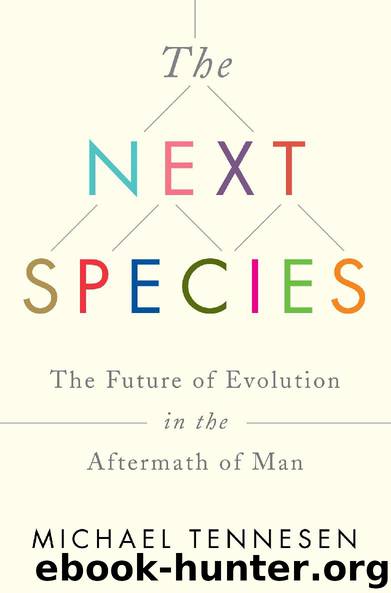Next Species by Michael Tennesen

Author:Michael Tennesen
Language: eng
Format: epub
Publisher: Simon & Schuster
11
PREDATORS WILL SCRAMBLE
OVER THE LAST 600 million years, during most of the extinction events, predators were the last to go. During the Cretaceous extinction, which knocked out the dinosaurs, the asteroid’s impact created clouds of gases and dust that blocked out light. This killed off the plants, which knocked off the plant eaters, and took out the predators, which ate plant eaters for lunch. Plants, plant eaters, and predators were the sequence then, but this time we’re attacking both ends. We’re killing off our plants, which are at the bottom of the food chain or “web,” as biologists prefer to call it, while at the same time going after predators, at the top of the web. We’re killing off predators first, either because they have valuable appendages (shark fins, rhino horns, elephant tusks) or because they take our domestic animals, or simply because, once in a while, they get one of us.
There are unique consequences for this top-down approach, says Jim Estes, professor of ecology and evolutionary biology at the University of California, Santa Cruz, when I visited with him at the Long Marine Laboratory on campus. He witnessed some of the top-down consequences in 1970 when, as a graduate student, he was sent to the Aleutian Islands between Alaska and Russia to study sea otters. One of his professors had urged him to address the role of sea otters as predators within the Aleutian ecosystem. “It never dawned on me that that would be an interesting question,” says Estes.
The Aleutian Islands are a chain of volcanic islands that stretches from the Alaska Peninsula toward the Kamchatka Peninsula, creating the boundary between the Bering Sea and the North Pacific Ocean. This is an area of stormy seas where one is not likely to find cruise ships, rustic inns, or tourists. Amchitka Island within the chain was used as an airfield during World War II but is currently uninhabited. Northern sea otters were nearly wiped out by fur hunters here in the late nineteenth century but an international treaty in 1911 stopped the pillage. By the 1970s the northern sea otter had recovered over vast areas of its former range, but not all. This gave Estes a unique vantage point from which to understand the value of a predator within a maritime ecosystem by viewing islands with and without otters.
In the first weeks of the study, Estes piloted a boat around Amchitka, past submerged rocks and into foggy inlets, here and there diving under the icy waters to get a glimpse of what lay below. Around the craggy underwater shorelines, the seas were filled with kelp plants that grew up from the bottom offering a respite, nursery, and feeding grounds for a wealth of marine creatures. Kelp is one of the fastest-growing plants on earth: under ideal conditions it’s capable of growing up to two feet in a day and can reach 175 feet in height in a matter of months. Beneath the surface, the kelp rises like an undersea forest. Large golden leaves attach to long thin stalks that sway with the movement of the currents.
Download
This site does not store any files on its server. We only index and link to content provided by other sites. Please contact the content providers to delete copyright contents if any and email us, we'll remove relevant links or contents immediately.
The Lonely City by Olivia Laing(4113)
Animal Frequency by Melissa Alvarez(3750)
All Creatures Great and Small by James Herriot(3509)
Walking by Henry David Thoreau(3228)
Exit West by Mohsin Hamid(3174)
Origin Story: A Big History of Everything by David Christian(3133)
COSMOS by Carl Sagan(2944)
How to Read Water: Clues and Patterns from Puddles to the Sea (Natural Navigation) by Tristan Gooley(2849)
Hedgerow by John Wright(2772)
The Inner Life of Animals by Peter Wohlleben(2763)
Origin Story by David Christian(2677)
How to Read Nature by Tristan Gooley(2657)
Project Animal Farm: An Accidental Journey into the Secret World of Farming and the Truth About Our Food by Sonia Faruqi(2656)
How to Do Nothing by Jenny Odell(2640)
A Forest Journey by John Perlin(2584)
Water by Ian Miller(2579)
The Plant Messiah by Carlos Magdalena(2451)
A Wilder Time by William E. Glassley(2358)
Forests: A Very Short Introduction by Jaboury Ghazoul(2331)
